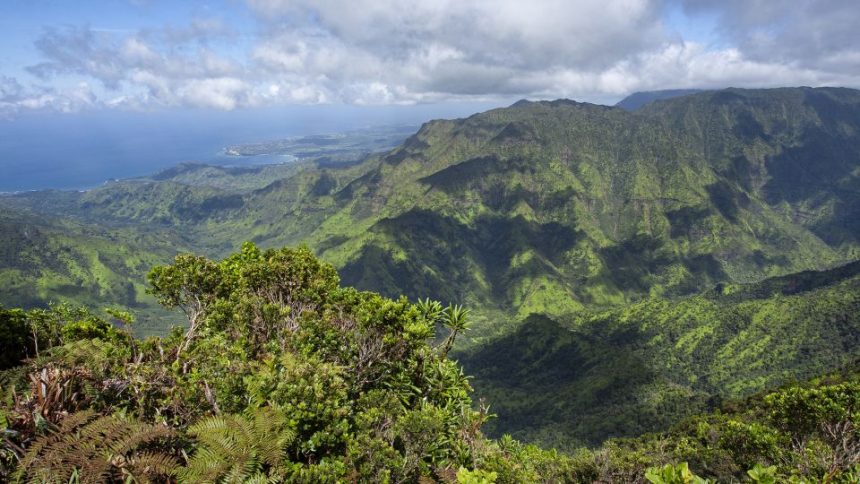Editor’s Note: Call to Earth is a CNN editorial series committed to reporting on the environmental challenges facing our planet, together with the solutions. Rolex’s Perpetual Planet Initiative has partnered with CNN to drive awareness and education around key sustainability issues and to inspire positive action.
In June, dozens of biodegradable pods fell from the sky over the forests of Hawaii. Each one, delivered by drone, contained about 1,000 mosquitoes.
These weren’t just any mosquitoes — they were non-biting, lab-reared male mosquitoes carrying a common bacterium that results in eggs that don’t hatch when the males mate with wild females. The hope is that they will help to control the archipelago’s invasive mosquito population, which is decimating native bird populations, such as rare Hawaiian honeycreepers.
The birds, which are key pollinators and seed dispersers and also play a central role in Hawaiian culture, are in dire straits. There were once more than 50 known species of honeycreepers in Hawaii, but today there are only 17 left, most of which are endangered.
Last year, the ‘akikiki, a small gray bird, went functionally extinct in the wild, and less than 100 of the yellow-green ʻakekeʻe are estimated to remain.
Development and deforestation have had an impact, but according to Dr. Chris Farmer, Hawaii program director for the American Bird Conservancy (ABC), the “existential threat” is avian malaria, which is spread by mosquitoes.
The insects are not native to Hawaii, but were first reported in 1826, likely unintentionally carried over by whaling vessels. “They caused waves of extinction,” says Farmer, as many native birds, such as the honeycreepers, had no resistance to the disease.
Since mosquitoes thrive in the warmer tropical habitats in the low elevations of Hawaii’s islands, the remaining honeycreepers found a refuge higher up in the mountains of islands such as Maui and Kauai, he explains.
Now, this is changing. “With climate change, we are seeing warmer temperatures and we’re watching the mosquitoes move up the mountains,” he says. “(In places like Kauai) we’re watching the populations of birds there just completely plummet.”
“It’s a constant march of mosquitoes moving up as the temperatures allow them and the birds getting pushed further and further up until there’s no habitat left that they can survive in.
“If we don’t break that cycle, we’re going to lose our honeycreepers,” he adds.
Searching for a solution
Conservationists have been searching for a solution to control mosquito populations and provide a lifeline to the honeycreepers. But dealing with mosquitoes on a landscape scale is difficult, says Farmer, who explains that the use of pesticides, for instance, would also damage native insect populations such as damselflies and fruit flies that are vital to ecosystems.
Honeycreepers have retreated to mountainous areas on islands such as Kauai. – San Diego Zoo Wildlife Alliance
Because mosquitoes are also such a huge threat to human health, spreading human malaria, dengue fever and the zika virus, among others, scientists have been studying the problem for decades, coming up with various solutions, including the incompatible insect technique (IIT).
This involves releasing male mosquitoes that have a strain of naturally occurring bacteria called Wolbachia, which causes non-viable eggs when they mate with wild females. Over time, with repeated releases, the wild population should decline as a result.
In 2016, ABC, together with Birds, Not Mosquitoes, a multi-agency partnership dedicated to protecting Hawaiian honeycreepers, decided IIT had the best chance of succeeding in Hawaii and started to investigate how to apply the same technique to mosquitoes transmitting avian malaria.
“The mosquito that transmits avian malaria is different from the one that transmits human malaria,” explains Farmer, so they began testing various strains of Wolbachia within the southern house mosquitoes found in Hawaii to determine which one was most effective.
The process took several years, due to “a combination of the science, community engagement and the regulatory process,” says Farmer, adding that, naturally, “whenever you say, ‘I want to release millions of mosquitoes in the forest,’ people have a lot of very legitimate questions.”
In 2022 they started ramping up production, rearing millions of mosquitoes with the chosen Wolbachia strain in a laboratory in California. The following year, they started releasing the insects in areas where the honeycreepers live in Maui, dropping them in biodegradable pods from helicopters.
“We have a rough estimate for how many mosquitoes there are in the wild, and we try to release 10 times as many of these Wolbachia mosquitoes, so (that they) find these females and are able to mate with them, and then their eggs don’t hatch,” says Farmer.
“Right now, we’re releasing 500,000 mosquitoes a week on Maui and 500,000 mosquitoes a week on Kauai,” he adds, using both drones and helicopters.
According to Farmer, it’s the first example globally of IIT being used for conservation purposes. If successful, he hopes it will inspire uses elsewhere. He warns, however, that while in Hawaii they felt confident using the technique because mosquitoes are an invasive species that have only been around for 200 years and therefore play no major ecological role, in other countries where they are native, the technique could have unintended repercussions to the ecosystem.
Buying time
One of the major barriers to releasing the insects in Hawaii has been the remote, mountainous terrain, prone to strong winds and unpredictable weather. The program has had to rely mainly on helicopters for releases, but these are expensive to run and there are a limited number on the archipelago, with competing needs for firefighting, safety and tourism, says Farmer. Often, missions have had to be called off last minute due to weather, he adds.
This is where drones come in. After months of testing the aerial vehicles in demanding conditions, checking their range, and designing protective, temperature-controlled parcels that can safely carry mosquitoes and be fixed onto the body, they successfully started deploying mosquitoes by drone in June.
It is the “first known instance of specialized mosquito pods being dropped by drones,” says Adam Knox, project manager for ABC’s aerial deployment of mosquitoes. “We have more flexibility with deployment timing in areas that generally have very unpredictable weather and it’s safer because no humans need to ride in the aircraft to deploy the mosquitoes.”
It also “reduces costs, team flight times, emissions and noise, which in turn means cheaper, more sustainable deployments,” he adds.
Farmer expects it to be a year or so before they will see the results of the deployments and whether the IIT technique is working. However, he is hopeful that it will help “buy time” for the birds to recover.

The ‘akikiki is functionally extinct in the wild. – Robby Kohley

An estimated 100 of the ʻakekeʻe remain in the wild, but it is hoped that the species could be saved by ongoing IIT efforts. – Graham Talaber
A recent study from San Diego Zoo Wildlife Alliance and Smithsonian’s National Zoo & Conservation Biology Institute found there is still time to save honeycreepers like the ʻakekeʻe from extinction if IIT mosquito control efforts are successful.
Christopher Kyriazis, postdoctoral researcher from San Diego Zoo Wildlife Alliance and lead author of the report, told CNN that their modeling demonstrated the urgency of the situation: “If you wait even a couple years, the window narrows really quickly.”
While IIT is “ambitious” and has never been used on this scale for these sorts of conservation aims before, he believes “there is hope for the species, if it can be effective.”
If mosquito populations were under control, there is the possibility that the honeycreepers would have time to replenish populations and with more genetic diversity, and may even develop their own resistance to avian malaria. There are already signs of that happening with one honeycreeper species, the ‘amakihi, on Hawaii Island, says Farmer.
However, Kyriazis cautions that “even if a (protective) mutation did arise at this point, for it to be able to spread through the population fast enough to save it is very unlikely.”
A safer environment would also give the opportunity to reintroduce captive populations of birds like the ‘akikiki; although it is extinct in the wild, some are being bred at bird conservation centers in Hawaii.
For Farmer, being at the forefront of this effort and seeing birds go extinct is “soul shattering.” But it also drives him.
“We have the ability to save these species,” he says. “If we don’t save these birds in this decade, then they probably won’t be here for the future. And so the ability to make a difference in the world, make a difference in the future, motivates us all.”
For more CNN news and newsletters create an account at CNN.com









